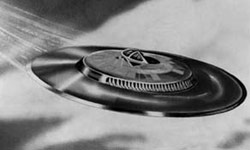 |
Avro Canada "Silver Bug" illustration released by DoD on 25 Oct 55 |
Caidin, Silver Bug
and the "Coanda Effect"
On October 25, 1955, US Air Force secretary Donald Quarles held a press conference in the Pentagon at which he released information on Avro Canada's USAF-funded project to build a supersonic, vertical takeoff and landing (VTOL) saucer-shaped aircraft. Known within the Air Force by its contract number, MX-1794, and by code names such as "Silver Bug," the craft had been under development in Toronto for about two years.
The popular press had a field day with the revelation. Articles about the saucer quickly appeared in a multitude of newspapers and magazines, such as US News and World Report ("Flying Saucers: You'll See Some Official Ones Soon," November 4), Mechanix Illustrated ("How the Flying Saucer Works," by Willy Ley, March 1956) and Flying ("The Coanda Story," by Caidin).

Mechanix Illustrated was produced by Fawcette Publications, which also published True, where Donald Keyhoe's seminal article "The Flying Saucers Are Real" had appeared almost six years before. Ley had a long history as an aerospace popularizer and worked closely with Walt Disney to help produce popular space documentaries throughout the 1950s.
Ley's 1956 article, clearly based on input from official sources, attributed the fantastic performance of the Avro saucer to "a new principle in aerodynamics," the "Coanda effect," an aerodynamic phenomenon in which a flowing fluid tends to remain attached to a curved surface, enabling the flow to be "bent" or directed as desired. In a VTOL aircraft, the effect can be used to divert the thrust of a jet engine downward to produce lift.
 |
Illustration from the Mechanix Illustrated article |
Caidin's article appeared in the May 1956 issue of the popular aviation magazine Flying. It began,
In the Pentagon recently, I was shown design sketches of a disc-shaped aircraft which had high speed, ability to hover, and could rise and descend vertically. This so-called 'flying saucer' project has been taken over by the USAF from Avro Aircraft Ltd., of Canada. The disc machine achieves its extraordinary performance through a phenomena [sic] known as the 'Coanda Effect'....
I was told: 'If we had listened to Coanda many years ago, and turned our engineers loose to develop his theories, jets would have been with us several decades before now. Coanda actually flew a jet in 1910.' This was news to me....
The offices of Air France in New York arranged a meeting with Professor Coanda, so I could learn at first hand of the unprecedented work this man has accomplished in the field of aeronautical science.
In the article, Coanda described his saucer design, which he called a "Lenticular Aerodyne," to Caidin as being based on four jet ducts utilizing his aerodynamic principle to provide both hovering capability and high-speed lateral motion.
It is clear that the Air Force strongly desired to get this story to the public on its own terms; strings were pulled to have the elderly Coanda flown to the US to meet and be interviewed by Caidin.
 |
click to enlarge |